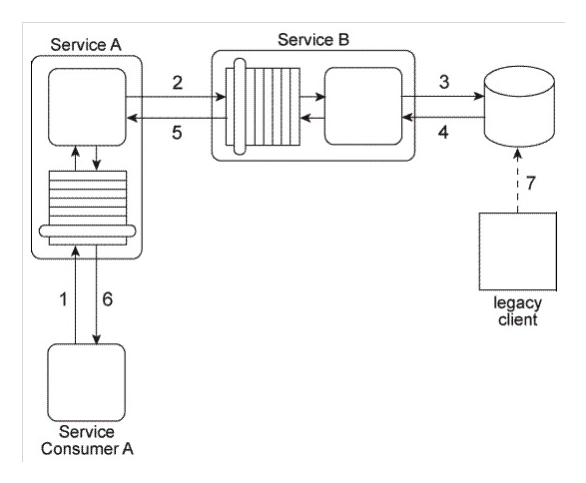Service A has become increasingly difficult to maintain. Its core service logic has become bloated and convoluted because it has been updated numerous times during which additional functionality was added to interact with the database and the legacy system and to support interaction with Service Consumers A and B (via the two service contracts) as well as interaction directly with Service Consumer C.  What steps can be taken to solve these problems and to prevent them from happening again in the future?
What steps can be taken to solve these problems and to prevent them from happening again in the future?
A) The Service Facade pattern can be applied to position a Facade component between the core service logic and the implementation resources (the database and the legacy system) and to also position a Facade component between the two service contracts and Service Consumers A and B. The Official Endpoint pattern can be applied to limit access to Service A to one of its two published service contracts. The Service Loose Coupling principle can be applied so that Service Consumer C does not negatively couple itself directly to the core service logic of Service A .
B) The Service Facade pattern can be applied to position a Facade component between the core service logic and the implementation resources (the database and the legacy system) and to position a façade component between the core service logic and the two service contracts. The Contract Centralization pattern can be applied to limit access to Service A to one of its two published service contracts. The Service Abstraction principle can be applied to hide the implementation details of Service A from service consumers.
C) The Service Façade pattern can be applied to position a Facade component between the core service logic and the two service contracts. The Contract Centralization pattern can be applied to limit access to Service A to one of its two published service contracts. The Service Loose Coupling principle can be applied so that Service Consumer C does not negatively couple itself directly to the core service logic of Service A .
D) None of the above.
Correct Answer:
Verified
Q1: Service Consumer A sends a message to
Q3: Our service inventory contains the following three
Q4: When Service A receives a message from
Q5: Service A is a task service that
Q6: The architecture for Service A displayed in
Q7: Service A is an entity service that
Q8: Our service inventory contains the following three
Q9: It has been confirmed that Policy A
Q10: You are told that in this service
Q11: Service A is a utility service that
Unlock this Answer For Free Now!
View this answer and more for free by performing one of the following actions

Scan the QR code to install the App and get 2 free unlocks

Unlock quizzes for free by uploading documents